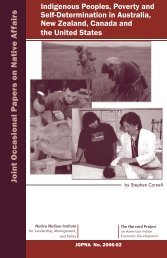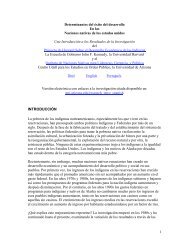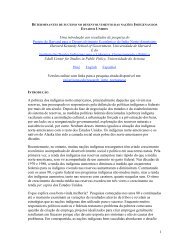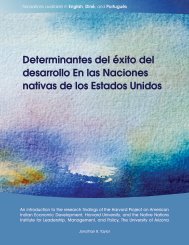American Indian Self-Determination - Native Nations Institute ...
American Indian Self-Determination - Native Nations Institute ...
American Indian Self-Determination - Native Nations Institute ...
- No tags were found...
You also want an ePaper? Increase the reach of your titles
YUMPU automatically turns print PDFs into web optimized ePapers that Google loves.
<strong>American</strong> <strong>Indian</strong> <strong>Self</strong>-<strong>Determination</strong>Stephen CornellJoseph P. Kaltsults in a productivity increase of 38,000 board feet of timber output,and the price received in the marketplace for that output rises by 4.5percent. This is accomplished within “allowable cuts” (i.e., maximumsustainable harvest levels) and with the quality of logs harvested heldconstant. The result is hundreds of thousands of dollars per year in additionalincome for the typical reservation forestry operation. 24Business Performance: Growing numbers of cases of business success in<strong>Indian</strong> Country are well-documented. Leading cases include:• The Winnebago of Nebraska Tribe’s Ho-Chunk, Inc. and its conglomerateof dot-com, financial service, construction, consulting,and retailing businesses now yields more than $100 million a year inrevenues. Over the last decade, reservation unemployment has beenlowered from around 70 percent to the point where every reservationcitizen able and willing to work has a job. Company earnings aresystematically plowed back into the community, and Ho-Chunk,Inc.’s non-profit arm is now building an entire town from scratch. 25• The Tulalip Tribes’ creation of the municipality of Quil CedaVillage and the Village’s heavy investments in otherwise-absentmunicipal infrastructure and services are the source of valueupon which a thriving commercial center is built. In the process,the Tribes have become the second largest employer in thecounty where they are located, north of Seattle, Washington. 26• In the late 1970s, the material assets of the Citizen Potawatomi Nation(noted above) consisted of 2½ acres of trust land, $550 in thebank, and an old trailer that served as the tribal headquarters. Today,CPN’s assets include a bank, a golf course, a recently-openedcasino, restaurants, a large discount food retail store, a tribal farm,a radio station, and more than 4,000 acres purchased by the Nation.CPN eschews per capita payments and, instead, channels itsresources into services for citizens – from health care to educationaland child development support, from a pharmacy to an award-winningsmall business development program. The directory of CPNbusinesses lists scores and scores of private citizen businesses, andCPN is the economic engine of the Shawnee, Oklahoma region. 2713







